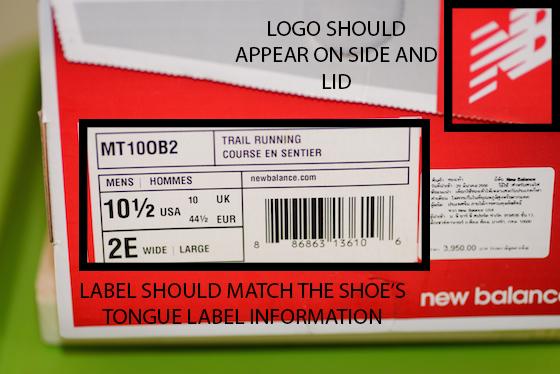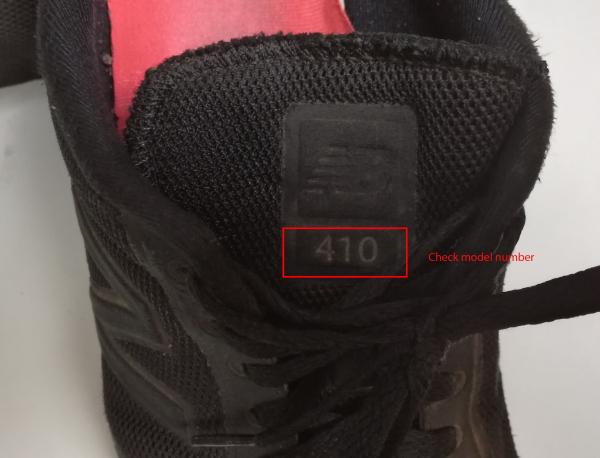
Over the years, New Balance has evolved into a global leader in athletic and lifestyle footwear. Nowadays, New Balance shoes are known for their comfort, style, and performance. Many popular models, like the 574 and 990 series, have become iconic lifestyle sneakers with a timeless appeal. But with their popularity comes the risk of encountering counterfeits. Don't let fakes steal your shine!
This oneHOWTO guide equips you with the knowledge to confidently identify authentic New Balance shoes. We'll reveal telltale signs like mismatched model numbers, suspicious branding, and other red flags that point towards fakes.
Inspect the packaging
Looking to add a pair of fresh New Balances to your collection? Star by looking at the box:
- The New Balance logo should be present on both the box lid and side. Compare it to official images online to ensure it's not a poorly replicated version.
- Look for any spelling errors on the box text. Authentic boxes have clear, professional printing.
- The information on the box label (color, size, style, and barcode) should all perfectly match the shoes inside.
- The barcode on the tongue label should be identical to the one on the box label. This ensures the shoes haven't been tampered with.
One final tip, some newer models have a rectangular hole on the box top revealing the brand name printed underneath.

Check for material quality
While a suspicious box is a red flag, the real test lies with the shoe itself. Here's what to watch out for:
Look for a well-defined "N" with a clean seam. Fakes might have a poorly stitched "N" with an irregular seam or the wrong width (thicker for regular shoes, thinner for running shoes).
Authentic New Balances have clean, centered stitching on the logo and throughout the shoe. Fakes often have messy or off-center stitching, and the fabric might be loose or poorly glued.
Genuine New Balance logos feature the registered trademark symbol "®" next to the letter "e." Replicas might have it next to the "w" or use a different font altogether.

Inspect the tongue
The tongue of your New Balance shoes holds valuable clues to authenticity.
Real New Balance shoes have a number on the tongue that corresponds to the specific model. For instance, a fake shoe might display "577" on the tongue when it's clearly designed to be a "574." Compare the number to the shoe's style and ensure they align.
Look for the New Balance brand name sewn onto the tongue, usually between the logo and the model number. This detail is often missing on fakes.
On the inside of the tongue, there should be a label with a barcode. This barcode number should match the one printed on the shoebox. Many legitimate New Balance shoes include a QR code on the label. Scan this code with your smartphone, and it should link you to the shoe's product page on the official New Balance website. Missing or non-functional QR codes raise red flags.
Authentic New Balance shoes typically display the size information on the tongue. Fakes, however, might list the size only inside the shoe.
Finally, keep in mind that many New Balance shoes feature metallic eyelets for the laces. While this is a common indicator of authenticity, it's not foolproof. Some genuine models, like the New Balance 373, don't have them. To be certain, check the official New Balance website for details specific to your shoe model.

Examine the sole
Examining additional areas of your New Balance shoes can further reveal their authenticity:
On the back of the shoe, near the sole, look for the iconic "NB" logo. Genuine New Balance shoes only display the logo, while fakes might include an additional "R" for "registered trademark." This "R" is a giveaway for a counterfeit.
Real New Balance shoes typically keep branding minimal on the sole, featuring only the logo on the heel. Fakes, on the other hand, might have the entire brand name printed on the sole. Running-focused New Balance shoes often have a distinctive design on the insole, featuring the letter "Y" repeated throughout. Casual wear New Balance shoes, however, usually have just the logo inside the insole.
It's important to note that some older New Balance models, like the 410 in the image, might have a different tread pattern (round circles) and even display the brand name with a registered trademark symbol on the last "e." If you're unsure about an older model, consult the official New Balance website for specific details.
Remember, a combination of these checks will give you a more accurate picture of your New Balance shoes' authenticity.

Other tips
Here are some additional tips to identify fake New Balance shoes and protect yourself from getting scammed:
- Purchase from authorized retailers: this is the safest way to ensure you're getting genuine New Balance shoes. Look for official New Balance stores or reputable online retailers who are authorized to sell the brand.
- Beware of “too-good-to-be-true” deals: if the price of a pair of New Balance shoes seems suspiciously low, it probably is. Do your research on typical pricing for the specific model you're interested in.
- Check the official New Balance website: the official New Balance website has a wealth of information on their products, including detailed descriptions, high-resolution images, and size guides. Use this resource to familiarize yourself with the specific model you're considering and compare it to the shoes you received.
Finally, as always, trust your instincts. If something about the shoes or the seller seems suspicious, it's best to err on the side of caution and avoid the purchase.
Think you've cracked the Reebok code? Test your skills with our other sneaker sleuth guides:
- Nike
- Adidas
- Reebok
If you want to read similar articles to How Do I Know if My New Balance Is Original?, we recommend you visit our Fashion & Style category.
- The material used for fakes and replicas is usually more rigid and worse quality than the originals.
- New Balance Fresh Foam models also have the